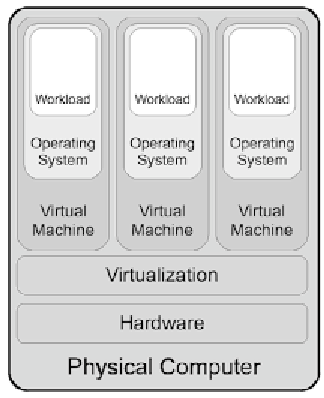Information Technology Reference
In-Depth Information
Then virtualization was created. At first, it was simply a means to consolidate
and isolate multiple workloads on one computer. Still, data centers soon needed
virtualization management software to cope with the quantity and etherealness
of virtual environments (VEs). In many ways, the needs are similar to those of
computer management: After all, VEs have life cycles similar to those of comput-
ers. To be useful, tools must ease the burden of managing dozens or hundreds of
VEs from creation to deletion.
The ease of VE deployment when compared to non-virtualized systems is lead-
ing to an explosion of managed entities. It also leads to another level in the hier-
archy of those entities, as shown in Figure 9.2.
Figure 9.2
Virtualization Adds Complexity
Then an interesting thing happened. People realized that other benefits could
be derived from these tools—benefits besides the simple financial efficiencies
brought by consolidation. Provisioning VEs became much simpler than provision-
ing an OS on “bare metal” (directly on the hardware). Taking a snapshot of a VE
and moving it across the data center, or to another data center entirely, offered
new architectural flexibility, and a new solution to small-scale disaster recovery.
All of these abilities, and more, enabled users to focus on the business value that
can be derived from virtualization.
This chapter describes the need for virtualization management software in
more detail. It begins by discussing life-cycle management for VEs, then explores
the newer uses for VE management. Finally, we use Oracle Enterprise Manager
Ops Center as an example of such software.


Search WWH ::

Custom Search